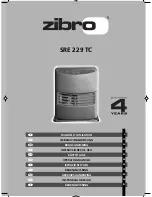
23
EN
CPA
Rev. 00 - 11/2018
1 USER'S MANUAL
1.1 Introduction
The new
CPA
is a high-performance, low-emission heater for domestic hot water produc-
tion, powered by
natural gas
or
LPG
and equipped with a compact,
WATER-COOLED
,
battery-powered burner with electronic ignition, designed for indoor installation.
1.2 Control panel
fig. 1 - Control panel
1
DHW temperature indication at the outlet
from the boiler
2
Battery charge indication. Fixed symbol:
Very low battery; change as soon as pos-
sible. When flashing, the battery is dead
and must be replaced.
3
Burner power adjustment
4
Temperature adjustment
5
Burner on indication
1.3 Turning the heater on and off
ATTENTION: WHEN THE UNIT IS WORKING, THE TEMPE-
RATURE NEAR THE PEEPHOLE MAY BE HIGH. AVOID CON-
TACT AS THERE MAY BE RISK OF BURNS.
Preliminary checks and operations
1. Make sure the hot water taps are closed.
2. Open the gas supply cock to the heater, located at the gas connection to the unit.
3. Check that the 1.5 V batteries are properly installed with the correct polarity (+/-). To
replace the batteries, see (3.4 Replacing the batteries).
4. Also verify that the batteries are sufficiently charged for heater operation.
1.3.1 Turning the unit on
Turn the knob to the required water heating level.
The unit will begin operating every time hot water is drawn.
fig. 2 - Turning the unit on
1.3.2 Turning the unit off
The burner goes off automatically when hot water is no longer demanded.
To use the unit again, no action is required.
To completely shut off the unit, place the knob in the () position.
fig. 3 - Turning the unit off
If the water heater will not be used for an extended period of time, close the gas cock
supplying the unit.
If the unit will be inactive for an extended period of time during the
winter, all water should be removed to avoid ice damage.
1.4 Settings
1.4.1 Setting the burner power manually
Use the knob (3 fig. 1) to select the heater power. You may choose between the minimum,
maximum, and intermediate positions, depending on the required heating power.
If the knob is turned counterclockwise, the unit will operate at maximum power. If the
temperature is too high, for example in the summer, or if you need a reduced flow of not
very hot water, turn the knob clockwise. This reduces the power, and therefore the gas
consumption. In the
●
position, the unit is turned off.
1.4.2 Setting the temperature
Turn the water temperature selector clockwise to increase the temperature, or counter-
clockwise to decrease it.
fig. 4 - Setting the temperature
1.5 Faults
Once the adjustments described above have been made, the heater is ready to operate
automatically. When a hot water tap is opened, an intermittent discharge is generated on
the ignition electrode to light the burner.
All electronic models have an ionization electrode built into the burner to monitor flame
presence. If a malfunction or lack of gas causes the heater to turn off, close the hot water
tap.
It is then necessary to eliminate the fault or obstacle preventing the gas from reaching the
heater, e.g., inadvertent closing of the gas cock, empty gas cylinder, etc.
To reactivate the heater, close and open the hot water tap.
If no hot water is produced after eliminating the cause and opening the hot water tap,
repeat the process.
If the problem persists, call the technical support center.
Table 1 - Faults
The burner does
not ignite
Absence of gas
Check the flow of gas
to the heater, and make
sure the pipes have been
purged.
Failure of the
ignition/detection
electrode
Check the electrode
cable, and make sure it's
properly connected and
free of deposits.
Defective gas valve
Check and/or change the
gas valve.
Activation of the
over-temperature
protection
Damaged or badly
positioned heating
sensor
Check that the heating
sensor is properly instal-
led and operating and/or
change it.
Activation of the
flue gas thermo-
stat (after this
operation, the unit
is reset by turning
on the tap, and
the thermostat
cools off).
Flue gas thermostat
contact open
Check the thermostat.
Cables
disconnected
Check the connections.
Thermostat
obstructed or
incorrectly sized
Check the thermostat.
Probe disconnected
Check the connection or
change the probe.
















































